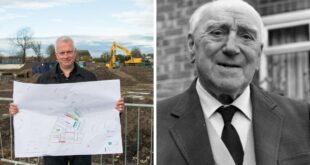A plan to try to control the amount of high-rise student accommodation being built in a part of Nottingham has been adopted by the city council amid concerns a ‘monolithic’ barrier could split the area in two. The authority has drawn up what’s known as a ‘Supplementary Planning Document’, or SPD, to provide housing developers with clear guidance on what the authority expects in the Eastside.
This area includes the Creative Quarter, Sneinton Market, Victoria Park and St Mary’s Rest Garden, as well as parts of Lower Parliament Street, Glasshouse Street and Huntingdon Street. Its extensive history dates back to the second half of the 18th century, when housing was first developed during a shortage of cheap workers’ homes.
Today it is a centre for creative, independent businesses, but some of those living and working in the area have raised concerns at the number of purpose-built student accommodation schemes springing up in the area. A public consultation held in 2021 attracted comments from a number of people saying they were worried taller buildings could act as a wall or barrier between the city centre and the east.
Development of the SPD began a number of years ago, and the final blueprint was approved by councillors at an Executive Board meeting on July 18. Portfolio Holder for Highways, Transport and Planning, Cllr Angela Kandola (Lab), said: “Regeneration of the Eastside area aims to deliver high quality housing, attractive to a wide range of households, to promote mixed and balanced communities, improved public realm and enhance connections between the Eastside, the city centre and adjoining neighbourhoods.”
Council data shows more than 50 per cent of all residential spaces in the area are for students. Some new schemes are already under way, including the building of a 13-storey block in Bath Street on the site of the former Royal Mail sorting office.
Another block is being built on a section of land in King Edward Street and Kent Street, where remains of the 19th Century Nottingham Borough Prison were uncovered during the excavation of a 200-year-old cave system beneath the site. While the council says it is not possible to stop any further purpose-built student accommodation in the Eastside, because it has a statutory obligation to meet local housing needs for all sections of the population, all developers will now be required to submit evidence as to why any new scheme is needed.
The SPD says: “Since 2004 there has been a development of larger buildings both in height and urban grain, particularly on Huntingdon Street in the form of Marco Island, Glasshouse and Litmus Building. “The scale and grouping of these buildings along with the Victoria Centre flats has created the impression of a wall being formed between the city centre and adjoining neighbourhoods when viewed from the east of the city.
“New development should look to preserve and enhance the existing urban grain and should aim to avoid a large monolithic form which will perpetuate the physical and psychological perception of a large barrier between the city centre and adjoining neighbourhoods.” All new development will also be required to achieve a high standard of environmental sustainability and an appropriate balance in the type of housing.
Cllr Kandola added: “In line with our ambitions to become carbon neutral by 2028, we also want to encourage a range of measures that developers can employ to reduce carbon in their development proposals. “These relate to energy efficiency, renewable energy and sustainable design and construction.”



